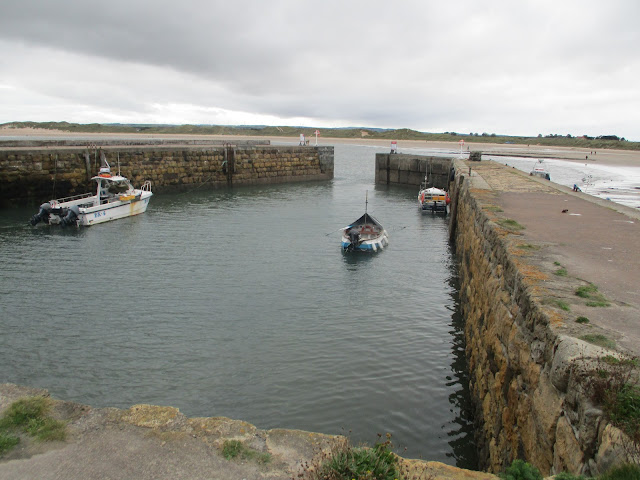Holidays and family commitments have reduced the team again. Four of us on another well worn and loved path from the coastal town of Seahouses to the nearly coastal village of High Newton.
A linear walk, we are leaving cars in the car park at High Newton, taking the bus to Seahouses and walking back.
The map that covers the walk is OS Explorer 340 Holy Island and Bamburgh. (And Explorer 332 Alnwick and Amble) Neither are essential.
Head north on the A1, turn east north of Alnwick and follow signs for Seahouses, eventually seeing a sign for High Newton. There is a free car park on the right as you reach the village.
From the car park we walked the short distance to the centre of the village and after a few minutes a bus appeared. We all got on, using pensioners' passes of course. At the first junction I noticed the sighnpost said right for Seahouses, left for Craster. It looked like the wrong way so I asked a fellow passenger if the bus went to Seahouses. She said no, Craster, wrong bus. Nobody had taken notice of the destination board on the front. Quick change of plan, go to Craster and walk up the coast to Beadnell.
The bus turning point at Craster. John's hat blew off and over the fence but fortunately he was able to retrieve it. It was a windy but warm day.And off we went, heading north, passing Craster Harbour and crossing the fields to the fabulous ruin of Dunstanburgh Castle.
Craster harbour. Craster is famous for kippers. The Jolly Fisherman pub is famous for crab sandwiches.
Dunstanburgh Castle. Foundation stone laid in 1314 by Thomas of Lancaster
The Lilburne Tower at Dunstanburgh
The Lilburne Tower at Dunstanburgh
Not far beyond the castle we came to the famous anticline at Greymare Rock.
The famous anticline. This photo is for Brian.
A short distance beyond the anticline we descended to the sands of Embleton Bay and followed its curve to Low Newton by the Sea.
The golden sands of Embleton Bay.
At Low Newton we chose to go "over the top" rather than stick to the coast path. The footpath passes behind the tern nesting area on the beach and eventually reaches the footbridge over the wonderfully named Long Nanny river.
Long nanny and footbridge.
Once across the bridge we planted ourselves on a grassy bank for a Herbie: Skinny whips, ginger biscuits and snickers. (and the now famous Cheese Leek and Potato slice from Pukka Pies)
Lunch over we headed for the sands of Beadnell Bay and soon reached the Lime Kilns on the harbour.
Lime Kilns and the harbour at Beadnell.
We walked up the street that faces the sea, noticing most of the houses are holiday lets and were unoccupied before turning left and heading for the cafe next to the bus stop. After tea and scones we had a wait before the bus arrived, it was the right one this time and soon we were back in High Newton by the Sea.
St Ebbas Beadnell, built in 1740 Tea and scones at the Salt Water cafe.
The walk is 8 miles, easy going.




















No comments:
Post a Comment